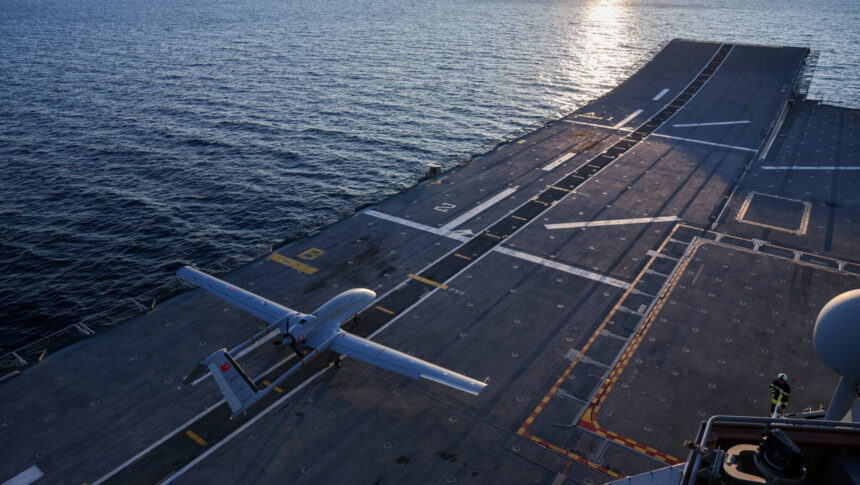Baykar, the Turkish defence giant, has proclaimed a significant milestone in the development of unmanned aerial vehicle (UAV) technology. The Bayraktar TB3 has successfully completed its first takeoff and landing on the Turkish Navy’s flagship vessel, TCG Anadolu. This historic flight establishes Turkey as a critical participant in the integration of UAV technology with naval operations.
The landmark test was conducted on November 19 at the convergence of the Mediterranean and Aegean Seas. A first for Turkey’s expanding fleet of domestically-produced drones, the Bayraktar TB3 UCAV successfully took off and grounded on the short runway of the TCG Anadolu without the necessity of any landing support equipment. After months of rigorous trials, which included open-sea shipboard evaluations, the flight lasted 46 minutes.
A New Era in Naval Operations
The Bayraktar TB3, a naval adaptation of the highly regarded Bayraktar TB2, boasts advanced capabilities, such as the ability to fold wings for stowage and deployment from compact shipboard environments. The TB3 is specifically engineered for maritime missions and is capable of conducting reconnaissance, assault missions, and other naval operations.
Baykar praised the exercise as a world first for a UAV to operate from a short-runway vessel such as the TCG Anadolu. After Turkey was excluded from the F-35 program, the vessel was repurposed as a drone carrier, initially designated for F-35B fighter jets. It currently functions as a floating centre for state-of-the-art unmanned systems, such as the Bayraktar TB3 and the jet-powered Kızılelma.
Comprehensive Testing and Training
Bayraktar TB3 units underwent extensive flight training between Dalaman Air Base Command and Baykar’s Flight Training and Test Centre in Edirne in anticipation of the milestone. The TCG Anadolu’s reliability and adaptability were demonstrated through the successful execution of both day and night operations.
In its press release, Baykar asserted that the Bayraktar TB3’s capacity to land and take off on a ship with a limited runway represents a significant advancement in naval drone operations. “This accomplishment serves as a testament to Turkey’s dedication to the development of indigenous defence technologies.”
Global Consequences
Turkey’s demonstration signals a change in global naval strategies by establishing it as one of a small number of nations that are capable of deploying drones from naval platforms. Baykar asserts that it has identified a world-first capability; however, other nations have also investigated comparable capabilities. The US Navy has conducted demonstrations on the HMS Prince of Wales with General Atomics’s Mojave drone, and reports indicate that China is developing carriers that are specifically designed for drone operations.
This achievement is indicative of the increasing significance of unmanned aerial vehicles (UAVs) in contemporary warfare, as navies worldwide strive to expand the capabilities of drones. The future of naval power is being reshaped by the integration of UAVs with naval platforms, which provides extended reach, operational flexibility, and cost efficacy.
Strategic Importance
The Bayraktar TB3’s successful deployment has added a critical capability to Turkey’s maritime arsenal as tensions in the Eastern Mediterranean continue to percolate. It also serves as a testament to the nation’s resolve to fortify its defence industry and expand its regional influence.
Turkey is well-positioned to expand its naval footprint and strengthen its role in global maritime security with the TCG Anadolu now completely operational as a drone carrier.
This accomplishment not only demonstrates Turkey’s technological advancements but also solidifies its position as a leader in the incorporation of naval unmanned aerial vehicles (UAVs), which has significant implications for the balance of power at sea.



